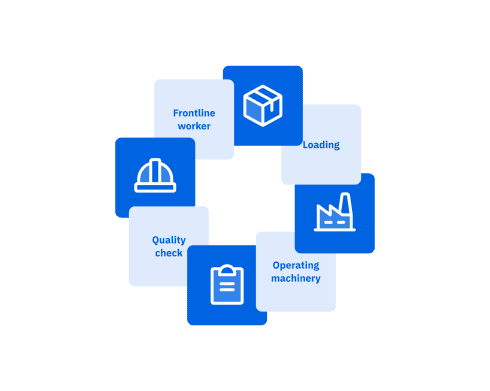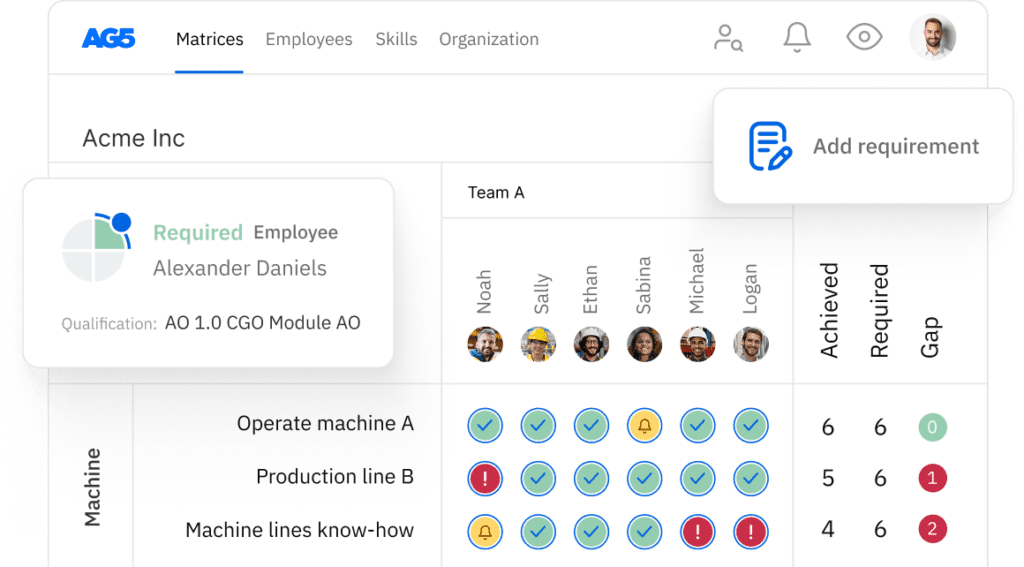How to improve operations and supply chain management for frontline workers
Want to boost productivity and efficiency throughout the supply chain? Our latest blog explores the roles frontline workers play in OSCM success, as well as challenges they face, and how AG5 can help speed things along.

Despite advances in automation and artificial intelligence, frontline workers remain the backbone of operations and supply chain management. Organizations worldwide are grappling with unprecedented challenges in managing their frontline workforce while maintaining efficient supply chain operations.
In this blog, we’ll take a brief look at the definition of operations and supply chain management (OSCM) before moving on to key challenges organizations face in managing frontline workers in OSCM environments – as well as how AG5 can help you surmount them.
What is operations and supply chain management (OSCM)?Copied
Operations and supply chain management encompasses the processes, resources, and people required to deliver products and services to customers.
Operations management tends to focus on how a company can most efficiently turn inputs – like raw materials, labor, and equipment – into outputs, such as finished products or services. Supply chain management extends this concept across an organization’s network of suppliers, manufacturers, distributors, and retailers
For frontline workers, this translates to a complex ecosystem where roles like manufacturing technicians, warehouse operators, logistics coordinators, and quality control specialists must collaborate to ensure seamless and efficient day-to-day operations.
Key challenges in frontline operations and supply chain management
Effective OSCM requires frontline workers to understand both their immediate responsibilities, and how their work connects to broader business goals.
These workers directly impact:
- Production schedules
- Inventory levels
- Quality standards
- Customer satisfaction
Because there are so many moving parts to a well-implemented OSCM strategy, organizations face a number of challenges. These challenges are intensified by modern supply chains’ complexity, requiring frontline workers to manage more variables, respond to faster-changing conditions, and maintain higher levels of coordination across global networks.
Digital transformation initiatives, while beneficial, often create additional training burdens and adaptation challenges for the existing workforce. These challenges – experienced by 90% of organizations [1] — are precipitated by several factors.
Skill gaps and training deficiencies
The World Economic Forum reports that 50% of manufacturing industry leaders say skill gaps are a “major barrier” to overcoming OSCM-related challenges, especially regarding digitalization of processes and technology. [2]
With rapid automation and digital tools entering the workplace, frontline workers often lack the training to keep up. Traditional training methods – such as paper manuals and classroom sessions – are often slow, inflexible, and fail to adapt to real-time needs.
Workforce disengagement
Upskilling and effective training initiatives hinge on buy-in from frontline workers. However, only 21% are engaged at work, according to research from Gallup. [3]
For frontline workers, engagement is often lower due to lack of visibility into – or control over – career growth, minimal feedback, and little autonomy. Disengaged employees lead to higher absenteeism, lower productivity, and increased turnover, all of which are disadvantageous to efficient OSCM processes.
Operational silos
Many supply chain operations suffer from siloed data and disjointed systems. Frontline teams may use multiple spreadsheets, paper checklists, or outdated enterprise software. This fragmentation leads to errors, delayed responses, and poor cross-functional collaboration.
Labor shortages and turnover
The global logistics and manufacturing sectors continue to struggle with labor shortages. The US Department of Labor reported 4.7 million “worker separations” in 2023, while an EY report points toward a potential 2.1 million worker shortage in the manufacturing industry by 2023.
High turnover increases onboarding costs and places a heavier burden on remaining staff, further weakening operations, and labor shortages compound these challenge, resulting in reduced productivity and operational efficiency.
Workforce skills essential for operations and supply chain successCopied
The evolving nature of – and rise of digitization in – OSCM demands new skill sets from frontline workers. To build a resilient, efficient frontline OSCM workforce, companies need to prioritize upskilling and reskilling their employees’ hard and soft skills. We can categorize them in four areas, which we’ll outline below.
Technical proficiency
Frontline workers must operate equipment, use warehouse management systems, and understand and adhere to quality and safety standards. Familiarity with IoT devices, handheld scanners, or digital work instructions are increasingly valuable here.
Problem-solving and critical thinking
As supply chains become more complex, workers must troubleshoot issues, adjust to unexpected changes such as delivery delays or equipment malfunctions, and make quick decisions on the work floor.
Collaboration and communication
Whether coordinating across shifts or with logistics partners, effective communication is essential to maintaining operational flow. Workers need soft skills to collaborate in team environments and report issues clearly.
Digital literacy
Understanding and using digital platforms is now a basic requirement for nearly 70% of frontline roles, meaning digital literacy is a non-negotiable. [6] This includes using sophisticated ERP systems, interpreting data analytics dashboards, using mobile applications for inventory tracking, and communicating through digital collaboration platforms.
How use AG5 to streamline operations and supply chain managementCopied
AG5’s skills management platform offers a comprehensive solution for addressing the complex workforce challenges organizations face when implementing and maintaining effective OSCM strategies.
With AG5, you’ll benefit from:
- Real-time skills visibility. With easy to use, up-to-date skills matrices that provide instant insights into workforce capabilities across multiple teams, departments and sites. Managers can see which workers are certified for specific tasks or machinery—enabling better shift planning and task assignment
- Streamlined compliance and training. Track compliance with regulatory requirements such as ISO, OSHA, or internal quality standards. Managers and employees will receive automatic alerts when certifications are due for renewal. AG5 also integrates with your existing LMS to streamline training delivery
- Reduced onboarding time. New hires will become productive faster with clear visibility into required competencies and easy access to learning paths. AG5 allows you to tailor onboarding checklists to the specific role, so you’ll never miss a critical step
- Data-driven decision-making. With centralized data, you can analyze skill gaps across your organization, and quickly and easily identify future training or recruitment needs. This helps with workforce planning, reduces operational bottlenecks, and prepares teams for automation and digital transitions
- Employee empowerment. AG5 provides employees with clarity regarding their own skills profiles and career development opportunities. This fosters engagement and improves retention rates, so your employees stay productive and valuable
Ready to get started? Schedule a free, live, 15-minute demo to see how AG5 would work in your organization.
Sources Copied
- Change view: Table
-
APA
| # | Source title | Description | Publication | Retrieved | Source URL |
|---|---|---|---|---|---|
| 1 | Supply chains: Still vulnerable | McKinsey | October 14, 2024 | June 5, 2025 | https://www.mckinsey.com/capab.. |
| 2 | Putting people first: a new imperative for manufacturing | World Economic Forum | December 17, 2024 | June 5, 2025 | https://www.weforum.org/storie.. |
| 3 | Global Engagement Falls for the Second Time Since 2009 | Gallup | April 23, 2025 | June 5, 2025 | https://www.gallup.com/workpla.. |
| 6 | Over 60% of jobs in manufacturing require specific digital skills from applicants | Engineering Update | January 9, 2020 | June 5, 2025 | https://engineering-update.co... |

